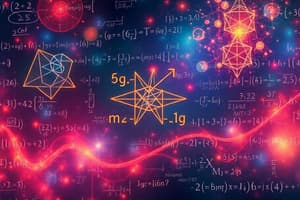Podcast
Questions and Answers
What is the primary function of a variable in algebra?
What is the primary function of a variable in algebra?
- To represent unknown values (correct)
- To express relationships between known quantities
- To represent fixed numerical values
- To denote operations like addition or multiplication
What does the distributive property illustrate?
What does the distributive property illustrate?
- You can distribute a multiplied term across a sum (correct)
- Multiplying numbers results in an increasing sequence
- Dividing retains the same sum as the original numbers
- Addition can be simplified by grouping
Which of the following correctly follows the order of operations?
Which of the following correctly follows the order of operations?
- 3 + 5 * 2 - 8 * 4
- 3 + (5 * 2) - (8 / 4) (correct)
- (3 + 5) * 2 - 8 / 4
- 3 + 5 * 2 - 8 / 4
What type of algebra focuses on vector spaces and linear mappings?
What type of algebra focuses on vector spaces and linear mappings?
Which of the following represents an inequality?
Which of the following represents an inequality?
In the equation $2x + 3 = 7$, what is the value of x?
In the equation $2x + 3 = 7$, what is the value of x?
Which statement about quadratic functions is true?
Which statement about quadratic functions is true?
What is factoring in algebra?
What is factoring in algebra?
Flashcards are hidden until you start studying
Study Notes
Algebra
-
Definition: A branch of mathematics dealing with symbols and the rules for manipulating those symbols; it represents numbers in general form.
-
Key Concepts:
- Variables: Symbols (e.g., x, y) used to represent unknown values.
- Constants: Fixed values (e.g., numbers like 2, -5).
- Expressions: Combinations of variables and constants (e.g., 3x + 2).
- Equations: Mathematical statements asserting the equality of two expressions (e.g., 2x + 3 = 7).
-
Operations:
- Addition and Subtraction: Combining or removing quantities.
- Multiplication and Division: Repeated addition or partitioning of quantities.
- Exponents: Representing repeated multiplication (e.g., x^2 = x * x).
-
Types of Algebra:
- Elementary Algebra: Basic operations, solving linear equations, and working with polynomials.
- Abstract Algebra: Studies algebraic structures like groups, rings, and fields.
- Linear Algebra: Focuses on vector spaces and linear mappings between them.
-
Key Principles:
- Order of Operations: PEMDAS (Parentheses, Exponents, Multiplication and Division, Addition and Subtraction).
- Distributive Property: a(b + c) = ab + ac.
- Factoring: Expressing an expression as a product of its factors (e.g., x^2 - 9 = (x - 3)(x + 3)).
-
Solving Equations:
- Linear Equations: Solving for x in ax + b = c.
- Quadratic Equations: Solving ax^2 + bx + c = 0 using factoring, completing the square, or the quadratic formula.
- Inequalities: Expressions that show the relationship between quantities (e.g., x + 3 < 5).
-
Functions:
- Definition: A relation that assigns exactly one output for each input.
- Types: Linear functions (y = mx + b), quadratic functions (y = ax^2 + bx + c), and exponential functions (y = ab^x).
- Graphing: Visual representation of functions on a coordinate plane.
-
Applications:
- Used in various fields such as science, engineering, economics, and everyday problem-solving.
- Provides tools for modeling real-world scenarios and making predictions.
Algebra Overview
- A mathematical branch focusing on symbols and their manipulation, allowing for representation of numbers generically.
Key Concepts
- Variables: Represent unknown values; commonly noted as x, y, etc.
- Constants: Fixed, known values such as integers (e.g., 2, -5).
- Expressions: Combinations of variables and constants (e.g., 3x + 2).
- Equations: Statements of equality between two expressions (e.g., 2x + 3 = 7).
Operations
- Addition and Subtraction: Fundamental operations for combining or removing quantities.
- Multiplication and Division: Represented as repeated addition or partitioning.
- Exponents: Indicate how many times a number (the base) is multiplied by itself (e.g., x² = x * x).
Types of Algebra
- Elementary Algebra: Basis operations, solving linear equations, and working with polynomials.
- Abstract Algebra: Examination of algebraic structures, including groups, rings, and fields.
- Linear Algebra: Deals with vector spaces and linear mappings among them.
Key Principles
- Order of Operations: Follow PEMDAS for solving expressions: Parentheses, Exponents, Multiplication and Division (left to right), Addition and Subtraction (left to right).
- Distributive Property: Facilitates expansion, expressed as a(b + c) = ab + ac.
- Factoring: Process of breaking down an expression into products of its factors, e.g., x² - 9 = (x - 3)(x + 3).
Solving Equations
- Linear Equations: Determine x from equations in the form ax + b = c.
- Quadratic Equations: Can be resolved using methods like factoring, completing the square, or applying the quadratic formula in the standard form ax² + bx + c = 0.
- Inequalities: Describe the relation between quantities (e.g., x + 3 < 5).
Functions
- Definition: Assigns one unique output for each input.
- Types of Functions:
- Linear Functions: Typically in the format y = mx + b.
- Quadratic Functions: Follow the form y = ax² + bx + c.
- Exponential Functions: Represented as y = ab^x.
- Graphing: Visual display of functions plotted on a coordinate plane.
Applications
- Algebra plays a crucial role in various disciplines, including science, engineering, and economics.
- Provides essential tools for modeling real-life situations and aids in making predictions.
Studying That Suits You
Use AI to generate personalized quizzes and flashcards to suit your learning preferences.




